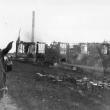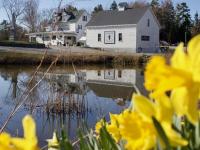This Week in Lincolnville: An untranquil beginning
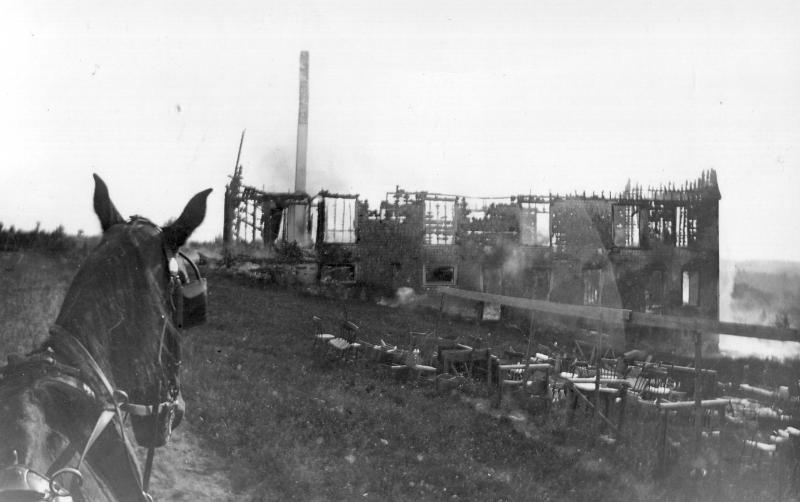 Such a heartbreaking sight for the hard-working men and women, Grange members all, who saw their months and years of work go up in smoke. This structure definitely appears to be similar to the photo of the second, nearly completed Grange below.
Photo courtesy of the Lincolnville Historical Society
Such a heartbreaking sight for the hard-working men and women, Grange members all, who saw their months and years of work go up in smoke. This structure definitely appears to be similar to the photo of the second, nearly completed Grange below.
Photo courtesy of the Lincolnville Historical Society
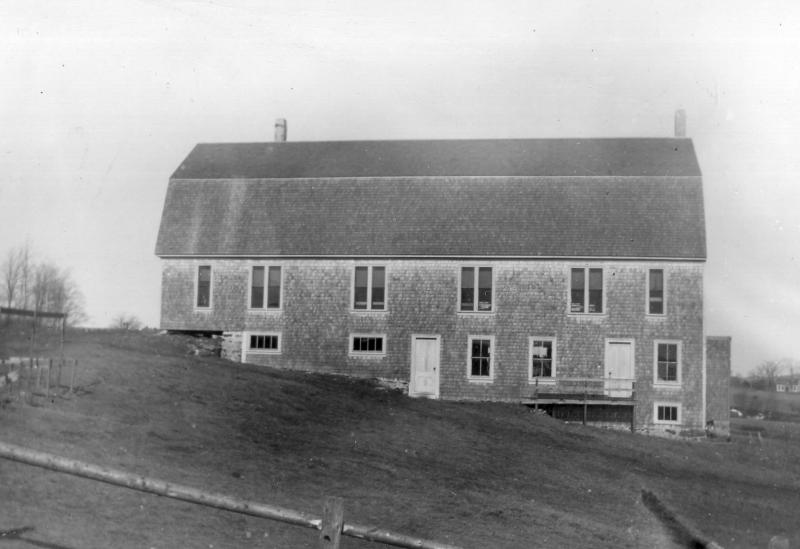 The Grange on the eve of completion, and the eve of the fire that destroyed it. This building is considerably larger than the one that stands today, Tranquility Grange the Third.
Photo courtesy of the Lincolnville Historical Society
The Grange on the eve of completion, and the eve of the fire that destroyed it. This building is considerably larger than the one that stands today, Tranquility Grange the Third.
Photo courtesy of the Lincolnville Historical Society
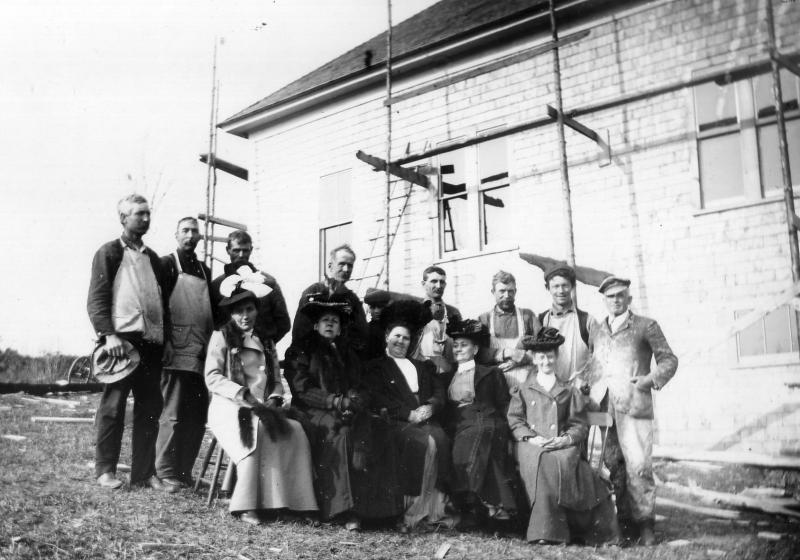 Workman and fund-raising women post next to what appears to be the doomed Grange the Second.
Photo courtesy of the Lincolnville Historical Society
Workman and fund-raising women post next to what appears to be the doomed Grange the Second.
Photo courtesy of the Lincolnville Historical Society
 The LCS lunch program includes this colorful produce from the school garden, as well as baked goods made on the spot.
Photo from LCS Newsletter
The LCS lunch program includes this colorful produce from the school garden, as well as baked goods made on the spot.
Photo from LCS Newsletter
 An example of an original design knitters can learn to make at the Library’s knitting workshop.
Photo by Diane O’Brien
An example of an original design knitters can learn to make at the Library’s knitting workshop.
Photo by Diane O’Brien
 Such a heartbreaking sight for the hard-working men and women, Grange members all, who saw their months and years of work go up in smoke. This structure definitely appears to be similar to the photo of the second, nearly completed Grange below.
Photo courtesy of the Lincolnville Historical Society
Such a heartbreaking sight for the hard-working men and women, Grange members all, who saw their months and years of work go up in smoke. This structure definitely appears to be similar to the photo of the second, nearly completed Grange below.
Photo courtesy of the Lincolnville Historical Society
 The Grange on the eve of completion, and the eve of the fire that destroyed it. This building is considerably larger than the one that stands today, Tranquility Grange the Third.
Photo courtesy of the Lincolnville Historical Society
The Grange on the eve of completion, and the eve of the fire that destroyed it. This building is considerably larger than the one that stands today, Tranquility Grange the Third.
Photo courtesy of the Lincolnville Historical Society
 Workman and fund-raising women post next to what appears to be the doomed Grange the Second.
Photo courtesy of the Lincolnville Historical Society
Workman and fund-raising women post next to what appears to be the doomed Grange the Second.
Photo courtesy of the Lincolnville Historical Society
 The LCS lunch program includes this colorful produce from the school garden, as well as baked goods made on the spot.
Photo from LCS Newsletter
The LCS lunch program includes this colorful produce from the school garden, as well as baked goods made on the spot.
Photo from LCS Newsletter
 An example of an original design knitters can learn to make at the Library’s knitting workshop.
Photo by Diane O’Brien
An example of an original design knitters can learn to make at the Library’s knitting workshop.
Photo by Diane O’Brien
“Waldo County has been especially unfortunate in having her Grange Halls burn, and Lincolnville has been the star sufferer. The Tranquility Grange has had anything but a tranquil time in keeping a home above their heads. Three grange halls have been burned under what was deemed by many, suspicious circumstances. But as no tangible clue could be obtained, the first two fires were set down as accidental.” — Waldo County Herald, October, 1908
Trying to unravel the tangle of Tranquility Grange’s early days is difficult; indeed, three different buildings burned between 1901 and 1908. The first, however, was known as Farmer’s Pride, and stood near the intersection of Belfast and VanCycle Roads. This building was also Jason Hills’ store and served as the post office for the north Lincolnville neighborhood, postmark: Grange, Maine. Farmer’s Pride must have had a lively membership judging from all the activities, which made it into the local newspapers at the time. Then in 1901 it burned; according to the Waldo County Herald, it was a suspicious fire.
Meanwhile, nearer to the Centre and the greater population, Tranquility Grange #344 was incorporated in 1898. These Grangers held their meetings in the old Town House (now gone) at the corner of today’s Townhouse and Belfast roads. In 1903 they purchased a parcel of land on Belfast Road from Eva Dean, and began planning for their new hall. Except for the fact that Allen Moody of the Centre was in charge of the committee that built it, no more is known about it; this is the mystery hall. No known photographs of it survive, nor any records of when it was built. Even the year of the fire that destroyed it is unknown, only that it did burn. Thus, this was the second grange fire referred to in the newspaper article, but the first Tranquility Grange fire.
Only a few memories of this building can be recalled. One is in a story told by Arne Knight when he was an old, old man, recollecting the day the Grange caught fire. He saw the smoke and jumped on his horse and rode bareback to the scene. Since he saw the smoke, it must have been daytime. He and others managed to get out some of the windows. Benches may also have been saved that day as can be seen in the foreground of one photo which does survive of a Grange fire. It’s not known if this is a photo of the first or second Tranquility Hall.
The second Tranquility hall was built beginning in December 1907. Young Arne was on the committee and in charge of keeping the accounts. His meticulous records survive in a bound account book. Work progressed until the end of May 1908, with carpenters, masons, teamsters, and painters coming and going. All was ready for the plasterers—the laths were installed and lime and horsehair stockpiled. On May 25, young Grover Knight was “tending mason”, assisting the plasterers—his father, Will, and Fred Andrews, a Rockport mason who was boarding at Arne Knight’s for the duration of the project. They worked a full nine-hour day, and when they closed the door and went home the smell of wet plaster must have mingled with the new wood and paint, the satisfying smell of a job nearly done. That night it caught fire and burned.
CALENDAR
MONDAY, Sept. 21
Schoolhouse Museum Open, 1-4 p.m., 33 Beach Road
LCS Soccer team, 3:45 p.m., at Appleton
TUESDAY, Sept. 22
Lakes & Ponds Committee, 7 p.m., Town Office
WEDNESDAY, Sept. 23
Schoolhouse Museum Open, 1-4 p.m., 33 Beach Road
LCS Soccer vs. Nobleboro, 3:45 p.m., Lincolnville
THURSDAY, Sept. 24
Free Soup Café, noon-1 p.m., Community Building, 18 Searsmont Road
FRIDAY, Sept. 25
Schoolhouse Museum Open, 1-4 p.m., 33 Beach Road
LCS Soccer, 3:45 p.m., at Belfast (Troy Howard M.S.)
Every week:
AA meetings, Tuesdays & Fridays at 12:15 p.m., Wednesdays & Sundays at 6 p.m.,United Christian Church
Lincolnville Community Library, open Tuesdays, 4-7, Wednesdays, 2-7, Fridays and Saturdays, 9 a.m.-noon. For information call 763-4343.
Soup Café, every Thursday, noon—1p.m., Community Building, Sponsored by United Christian Church. Free, though donations are appreciated
Schoolhouse Museum open by appointment only until June 2015: call Connie Parker, 789-5984
COMING UP
Oct. 3, Hat Knitting Workshop, Library
“When the third [fire] came — laying in ashes the new hall that had just come to the hands of the plasterers—the people were not only indignant but alarmed and they proceeded to make a rigid investigation. Detective Richard Leader of Lewiston was hired by the grange to ferret out the perpetrator of this last outrage, if possible. A bloodhound was procured from Thomaston State Prison which it was hoped might run down the incendiary, but things did not run smoothly, there came a rain and the bloodhound was worthless under the conditions and was returned.
“The selectmen worked with the Grange committee and detectives, and some clues were found. Trampled down grass, foot-prints that lead across the stubble in a field, a shorst sack with shavings inside, a bottle with an uncertain smell—that under normal conditions might have been considered as a former receptacle for prohibition whiskey—was declared to have a strong smell of kerosene, and as the sack also smelled of kerosene, it was decided that footprints, sack, shavings, and bottle, were all links in a chain of circumstantial evidence. Evidence that the community believed pointed toward one Mr. Clark. Mr. Clark protested that he didn’t think so, but he was arrested and held for the Grand Jury, hence his arraignment, his plea of not guilty, and the opening of the trial in the Supreme Judicial Court.
“Hon. Wm. P. Thompson, as County Attorney, opened the case in his usual masterly manner, acknowledging, however, that all the evidence he had was circumstantial, and he proceeded to call to the stand witness after witness, and there was a small army ready to testify—some seventeen in all.
“The courtroom was filled with people from Lincolnville, and as the witnesses testified, it was evident that they considered Mr. Clark did the job, but to tack it to him for good and sure was another proposition altogether.
“Clark is known to have done some very peculiar things. For instance, he came to the fire on a cold night, with nothing on except his under clothes and an old raincoat. No hat, no shoes or stockings. When asked why he did not go nearer to the fire as he stood there shivering, he remarked, ‘I’m as near as I want to be.’
“Tracks in the soil tallied—so far as size is concerned—very well with the size of shoes Clark wears, but there are others in Lincolnville who wear the same size shoes.
“…At the close of the testimony for the State, Hon. Lindley M. Staples, attorney for the defense, began the work of rescuing Clark. He ridiculed the showing of the State as only Lindley can, and emphatically stated that if it was not his desire to vindicate his client before the world he would ask the court to dismiss the case for want of evidence. But under the circumstances—not desiring that his client should go back to Lincolnville under a cloud—he proposed to continue and show that his client was not guilty.
“Several witnesses were called and put upon the stand to corroborate Clark’s story as to where he had been, and to show how he came to be at the fire in his underclothes with only a coat on.
“…at the close of taking testimony Mr. Staples addressed the jury for nearly an hour…[claiming] that an alibi had been proved and that Clark should be exonerated…[he] closed with an eloquent oration in which he spoke of the defendant’s mother, the love she held for her son, and her strong testimony presented upon the stand.
“…County Attorney Thompson [then]…explained why he had not cross examined other witnesses than the defendant…[and] that he expected that the parents and other members of the defendant’s family, would testify in his favor…[and] that while the defendant’s mother might a good woman, many good women were compelled to mourn over the crimes of their children. He asserted the fact that the Clark family owned a concert and dance hall whose business was interfered with by the grange hall, and this might be sufficient motive. He dwelt upon the fact that the defendant’s family were sleeping so soundly at the time of the fire that it took three calls to wake them, thus showing that they did not know the whereabouts of the son who might have been out of the house a long time, and yet had plenty of opportunity to return without their knowledge.
“…the jury…retired at 11:30, reporting a disagreement at 5:20 p.m. The jury was discharged and Clark furnishing $1,000 bonds, his parents being accepted as sureties, was allowed to return to his home.
“It is rumored that there were three for acquiting and nine for convicting.” Waldo County Herald, October 1908.
Thus, the trial ended in a mistrial. So far no record has been found that Mr. Clark was ever tried again for the crime, and by the 1910 census the Clark family are no longer listed as living in Lincolnville. The Tranquility Grange members somehow found the will (and funds) to rebuild their hall, the third building on the site! The same committee that oversaw the building of No. 2 hall undertook the job — Charles Moody, Henry Peavey, Lucius Knight and Arne Knight, headed up by Will Pendleton.
This time a more modest building was planned; no doubt less money was available. Arne Knight’s accounts make no mention of an insurance payment for either fire. Apparently M.C. Whitmore Company, the Camden building supply firm, extended financing to the Grange in February 1909 after the final hall was built, agreeing to accept payment of a $400 outstanding bill with interest over one year.
The cost of Hall No. 2, the one burned in May 1908, was one thousand two hundred forty dollars. Hall No. 3, completed in January 1909, the building which still stands today, was one thousand five hundred ninety-seven dollars. That the smaller Hall No. 3 should cost some three hundred and fifty-seven dollars more than No. 2 is probably because it was completed, while No. 2 burned before it was finished. Possibly Hall No. 1 wasn’t completely destroyed and some of the materials (including those windows) were salvaged. Hall No. 3 seemed to require more labor on the foundation than No. 2, perhaps an indication that Hall No. 1’s foundation had been partially salvageable.
Wages ranged from 16 1/2 cents an hour ($1.50 for a 9-hour day) for a common laborer to 25 cents ($2.25 a day) for the foreman to 33 cents an hour ($3.00 a day) for a skilled mason. Different crews worked on the two halls built by the Will Pendleton committee. Will Wood of Camden was foreman on No. 2, and W.P. Greenlaw of Northport was boss on No. 3. Out-of-town workers, including the masons, plasterers and painters, were boarded in local homes; Arne’s mother, Olive Knight, and Mrs. Henry Peavey both received payment for boarding these workers.
Some significant changes were made in Hall No. 3. Not only was it considerably smaller, but the walls and ceilings were made of steel; according to Arne’s accounts $102.56 was paid to Kinnear & Gager Company for them. No such purchase was made for No. 2. The other expenditure not made for No. 2 was the few dollars paid to Wilbur Mahoney to act as “watchman at night” as No. 3 neared completion at the end of 1908. That paid off.
from Staying Put in Lincolnville, Maine 1900-1950, available at Western Auto, Lincolnville Fine Art Gallery, Beyond the Sea, Schoolhouse Museum, and Sleepy Hollow Rag Rugs.
The above story from illustrates the frustration in writing about an event that happened over a hundred years ago. While the article about the trial of Mr. Clark is quite detailed as to the evidence, and the lawyers’ arguments for and against the accused, we don’t know if he was ever re-tried, found guilty or not, or served time. But fortunately, Arne Knight’s account book does survive, and is preserved at the Schoolhouse Museum, allowing us a glimpse into how a group of townspeople – Grange members – managed to build, not one, but three Grange halls in less than a decade. And this at a time when nearly everyone in town was living “close to the bone.”
Tranquility Grange, the one that lasted, still stands on Belfast Road, halfway between the Center and Slab City Roads. Step inside and, except for the patina of time, it could be the day the last workman packed up his things and went home. The pressed tin ceiling and walls, the beadboard wainscot, the stage, all as it was 100 years ago. If you’ve been to a Grange supper you’ve made your way down the dark stairway to the dining room; it makes a turn and then goes by the “pioneer bathrooms”, the indoor two-holer that serves in winter when the heat’s off and the flush is shut down. Nothing about the building says 21 st century or even 20 th.
Grange members number about ten today, and the youngest, the “baby”, is 75. By my count Lincolnville has ten “heritage” structures, that is, buildings that are historic and most are being maintained by dwindling numbers of (aging) volunteers. Here’s my list:
Bayshore Baptist Church - 1835, King David’s Lodge – 1865, Tranquility Grange – 1908, United Christian Church/Community Building – 1820/1960, Petunia Pump – 1920s, World War II Memorial – 1946, Library – 1849, Boat Club – 1950s, Bicentennial Bandstand – 2002, and Beach School (Lincolnville Improvement Association) – 1892.
What if we started a community heritage foundation in town, funded with grants and bequests and donations, a fund that could grant money toward maintenance of these structures? Think about it.
Lunch at LCS
We read a lot about the national effort to improve the nutritional value of school lunches, First Lady Michelle Obama’s campaign. Well, here’s what’s happening at Lincolnville Central School this year. FoodCorps, a part of AmeriCorps, is working with UMaine Extension and Camp Tanglewood to “recruit, train and place emerging leaders into Waldo County Schools”. LCS’ FoodCorps leader is Laurel Simone who will be working with LCS teachers to increase children’s nutrition education.. Read about the program she’ll be helping with in the latest Lynx newsletter. Of course, LCS already has a producing garden, and this is just the time of year that the lunch program benefits from all those fresh vegetables.
LCS Sports’ Schedules
The soccer team plays at Appleton on Monday, Sept. 21, at home vs. Nobleboro on Wednesday, Sept. 23, at Belfast on Friday, Sept. 25. The boys and girls cross country teams have a meet at Islesboro on Saturday, Sept. 26. Wally and I thought our LCS sports days were long gone, but with two granddaughters running cross-country how wrong we were! Check out the schedule for soccer and cross-country, and consider coming out for an afternoon of excitement, watching our teams. Sometimes it feels as though we’re two different towns – the young families and the retireds. Standing on the sidelines watching kids competing, cheering on our team is a great way to unite....
Knitting Workshop
I’ll be doing another knitting workshop at the Library on Saturday, Oct. 3, 10 a.m. to noon. Using a basic hat pattern, I’ll show how to add different elements to make an original design. Those who wish may bring a pair of double pointed needles and a ball of yarn to practice techniques such as I-cord, picot edge, braid stitch and duplicate stitch. There’s still plenty of time to knit a couple of hats for Christmas presents! This is the fourth in a series of fiber arts workshops supported by a generous grant given to the library in honor of Dale Mudge. The workshop is free but registration is required. For more information or to register, call 763-4343 or email.
Condolences
Along with many, many others in Lincolnville and in neighboring towns, I was sad to read that Pastor Dave Pouchot passed away. Pastor Dave brought so much caring and energy to our town, as he founded and grew Crossroads Community Baptist Church. Sympathy to his wife, Marian, his family, and to all his parishioners. I’m so glad to have known him ….
This and That
When was the last time you saw a Monarch butterfly? I asked that question a few weeks ago, and got some responses – one here, one there. The people who responded remembered exactly where and when they saw them. Isn’t that a far cry from the day, just a few years ago it seems, when Monarchs were everywhere? We saw them every day, and all over. We read that there are many stresses on the Monarch population, but there is one we can try to alleviate. Don’t cut down any milkweed (the plant the caterpillars eat) that’s growing on your property. Allow it to grow and go to seed. One friend told me he collects the pods in the fall and stores them in a paper bag. Come spring he takes the bag outside on a breezy day and opens it like a bellows, allowing all the fluffy, little milkweed parachutes to float up on the breezes and disperse.
It’s time for our young pullets to move in with Chico and his flock of older hens. Any day now they’ll start to lay their first eggs, little things, sometimes perfectly round like a small ping pong ball. We want them laying in nest boxes in the big hen house. That means moving out of the kids’ house and in with the big ladies. But try convincing 14 or so hyperactive, slightly hysterical young girls of that. We spent the first evening of the project trying to herd them calmly into the other house, but they kept piling up in front of their familiar coop. When a few did go in the right place, they’d turn right around and scoot out. Then we figured out we could build a narrow pathway using segments of our pea fence, sort of a chute that leads to only one place: the doorway to Chico’s domain. Tonight it worked like a charm.
My seashore-dwelling friend wrote the other morning, asking if I had any idea which huge planet shines light on the sea, perhaps as the moon does. Anyone?
Finally, a friend, who has worked as a docent and educator at Virginia’s Gunston Hall for many years, wrote that she was “on my way out to Gunston to join up with four other hearth cooks to clean the hearth kitchen there. It’s time to knock down spider webs, refresh our stored staples, polish the copper pots, carry out any stiff skinks we find in the firewood, give a sound sweep and mop to the brick floor. It will be fun with such good company...” and I complain about cleaning out the fridge!
Lincolnville Band Playing Sunday
Come out to hear the Lincolnville Band playing a free concert at the Bandstand at Breezemere Park (Nortons Pond), 3 p.m. Sunday.
Event Date
Address
United States






